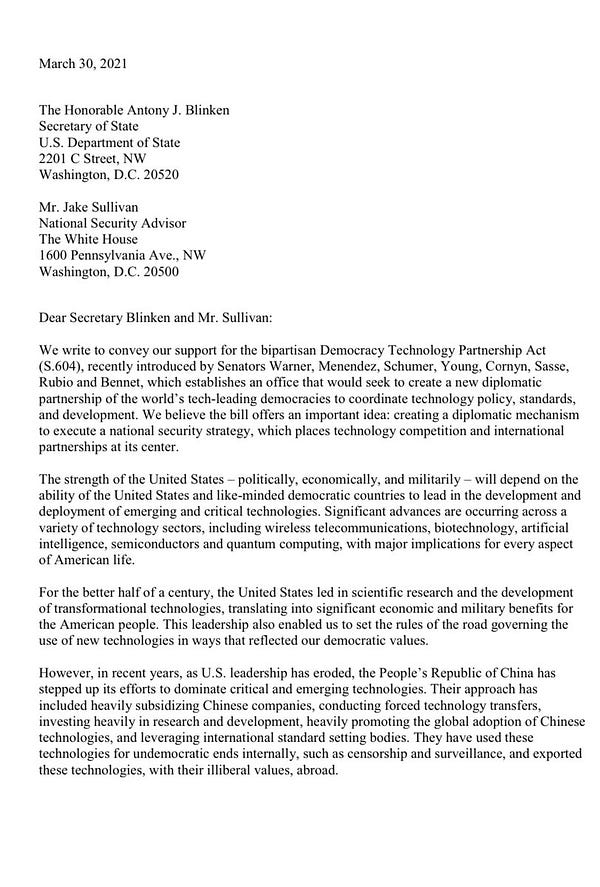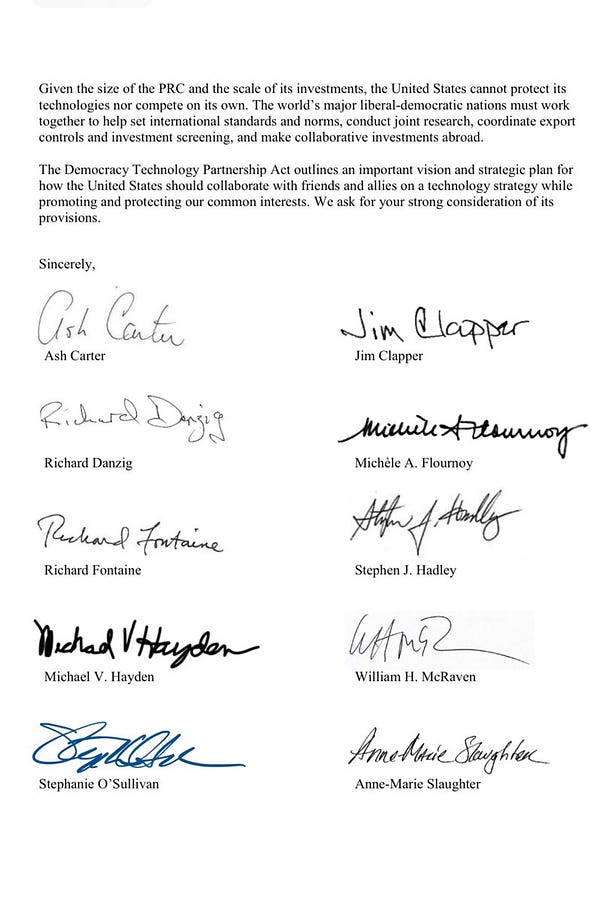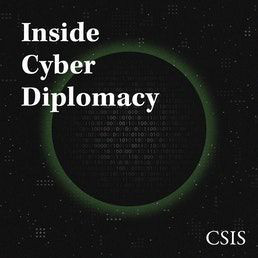Chinese state media and fringe groups cooporate on Xinjiang | How a boycott of clothing companies was executed | TikTok and US Far-right militias
Follow us on Twitter. The Daily Cyber Digest focuses on the topics we work on, including cyber, critical technologies & strategic issues like foreign interference.
A new ASPI report explores how the Chinese Communist Party (CCP), fringe media and pro-CCP online actors seek—sometimes in unison—to shape and influence international perceptions of the Chinese Government’s human rights abuses in Xinjiang, including through the amplification of disinformation. US based social media networks, including Twitter, Facebook and YouTube, along with Chinese-owned TikTok (owned by Chinese company ByteDance), are centre stage for this global effort. Since early 2020, there’s been a stark increase in the Chinese Government and state media’s use of US social media networks to push alternative narratives and disinformation about the situation in Xinjiang. Chinese state media accounts have been most successful in using Facebook to engage and reach an international audience. Australian Strategic Policy Institute
The Communist Party’s youth wing denounced H&M on social media and posted an archival photo of slaves on a Mississippi cotton plantation. Official news outlets piled on with their own indignant memes and hashtags. Patriotic web users carried the message across far and varied corners of the Chinese internet. Within hours, a tsunami of nationalist fury was crashing down upon H&M, Nike, Uniqlo and other international clothing brands, becoming the latest eruption over China’s policies in its western region of Xinjiang, a major cotton producer. The New York Times
TikTok’s account recommendation algorithm appears to be prompting users to follow far-right extremist movements, with Three Percenter, QAnon, Patriot Party, and Oath Keeper accounts all being pushed by the platform’s algorithm. These include far-right movements that were deeply involved in the planning and execution of the January 6 insurrection, which resulted in five deaths and nearly 140 injuries to police defending the Capitol. Media Matters
ASPI ICPC
Strange bedfellows on Xinjiang: The CCP, fringe media and US social media platforms
ASPI
This report explores how the Chinese Communist Party (CCP), fringe media and pro-CCP online actors seek—sometimes in unison—to shape and influence international perceptions of the Chinese Government’s human rights abuses in Xinjiang, including through the amplification of disinformation. US based social media networks, including Twitter, Facebook and YouTube, along with Chinese-owned TikTok (owned by Chinese company ByteDance), are centre stage for this global effort. Since early 2020, there’s been a stark increase in the Chinese Government and state media’s use of US social media networks to push alternative narratives and disinformation about the situation in Xinjiang. Chinese state media accounts have been most successful in using Facebook to engage and reach an international audience.
China Used Twitter, Facebook More Than Ever Last Year for Xinjiang Propaganda
The Wall Street Journal
@wsjeva
The Chinese government’s activity on Twitter and Facebook over its policies toward ethnic minorities in Xinjiang reached an all-time high last year, as Beijing sought to portray its approach, including use of widespread internment camps and surveillance, as beneficial to the remote northwestern region. The frequency of tweets about Xinjiang from Chinese state media and diplomatic Twitter accounts increased to an average of nearly 500 tweets per month in 2020, up from about 280 per month the prior year, according to new research from the Australian Strategic Policy Institute. On Facebook, the group found, public pages operated by Chinese state media were some of the most popular sources for posts on Xinjiang..With Xinjiang, one of Beijing’s strategies is attempting to shape discourse in ways that support China’s policies, said Jacob Wallis, a co-author of the report. But the other is a “much more combative discourse” against critical investigations of Xinjiang to dissuade others, along with sanctions, he said.
Too few indigenous people in tech
Information Age
Indigenous representation in cyber security and STEM-related industries remains “woeful”, and short-lived pilot programs are failing to build the trust needed to gain any real traction, a social policy analyst has warned, while noting that technical areas are missing out on a potentially invaluable pipeline of talent. Many indigenous youths grow up speaking “eight or nine” languages and develop problem-solving skills in a range of ways, Australian Strategic Policy Institute (ASPI) indigenous engagement specialist Dion Devow told attendees at AISA’s recent CyberCon 2021 conference..As part of ASPI’s IndigiCyber, Defence & Space Program, Devow has been exploring ways to “foreground the unique skills and perspectives of First Nations Australians in discussions on issues that affect them and in the formulation of solutions.”
Learn more about our IndigiCyber, Space & Defence program here


See our satellite mapping & research project Mapping conditions in Rakhine State here
Boogaloo Bois: the birth of a ‘movement’, from memes to real-world violence
The Strategist
@elisethoma5
However, what’s occurred over the past several years, and accelerated dramatically since the beginning of the global Covid-19 crisis, is the opposite process. Beyond just extremist movements generating memes, memes are now also inspiring extremist violence. It’s too early to fully understand how the dynamics of these digital-native forms of extremism may differ from more traditional extremism, which begins offline and later moves into online spaces.
Australia
Sophisticated and complex' is how one of this week's cyber attacks was described — so how did they happen?
ABC News
@manfield_evelyn
Both federal Parliament and Channel Nine faced major IT disruptions on Sunday, something one expert said could be a coincidence, but could also be linked to previous malicious attacks like those on Microsoft Exchange servers.
Calls to regulate online hate talk
The Australian
@jessmalcolm1
Minister for Women Marise Payne has called for strong new regulation to ensure hateful conversations on social media platforms do not erode the fabric of public discussion.
Government must rethink funding model to support technology in Australia’s public sector
The Strategist
@lesleyseebeck
In the modern economy, all companies are software organisations, whether they realise it or not. So too Australia’s federal government. But how the government works, how it accounts for money and allocates funds, have not kept pace with the modern world of technology—in particular, the integration of data and digital systems in everyday life. That’s not unexpected. Companies, too, are still coming to terms with that world. And our government—through habit and function—is highly risk-averse. As it should be; after all, people depend on it to get things right. However, the government is also responsible for setting the guardrails for the use of technology by others through policy and regulation.

China
How China’s Outrage Machine Kicked Up a Storm Over H&M
The New York Times
@zhonggg @paulmozur
The Communist Party’s youth wing denounced H&M on social media and posted an archival photo of slaves on a Mississippi cotton plantation. Official news outlets piled on with their own indignant memes and hashtags. Patriotic web users carried the message across far and varied corners of the Chinese internet. Within hours, a tsunami of nationalist fury was crashing down upon H&M, Nike, Uniqlo and other international clothing brands, becoming the latest eruption over China’s policies in its western region of Xinjiang, a major cotton producer.
Beijing Is Getting Better at Disinformation on Global Social Media
The Diplomat
@Sarah_G_Cook
When China-linked networks of social media bots and trolls appeared on the global disinformation scene in 2019, most analysts concluded that their impact and reach were fairly limited, particularly in terms of engagement by real users and relative to more sophisticated actors in this realm, like the Russian regime. As many China watchers anticipated, that assessment now seems to be changing.
The China-based foreigners defending Beijing from Xinjiang genocide claims
South China Morning Post
@ParkSuAm1996
Foreigners who depict China in a positive light are becoming increasingly important to Beijing’s counter-narrative to allegations of an ongoing genocide in the far-western region of Xinjiang. In a rare move, China’s foreign ministry last week used a speech by a Shenzhen-based Canadian vlogger to hit home its point that Western countries are targeting Xinjiang to contain China, rather than because of alleged human rights abuses being committed against the region’s Uygur ethnic minority. In a 12-minute presentation during a live online discussion on March 19, Canadian YouTuber Daniel Dumbrill, who runs a craft beer bar in the southern city of Shenzhen, explained why the US and Western countries wanted “to disrupt China and its relationships”. A video of the presentation was widely shared by Chinese state media, including broadcaster CGTN, as well as on social media platform Weibo. It was originally uploaded to YouTube, a platform blocked in China.
China using surveillance firms to help write ethnic-tracking specs
Reuters
@AASchapiro
Technical standards published by surveillance research group IPVM specify how data should be segmented by dozens of characteristics - from eyebrow size to skin tone.
Chinese Big Tech's shadiest practices
Protocol
@shenlulushen
For years, Chinese authorities took what they called a "tolerant and cautious" approach to Big Tech, hoping a light touch would enable innovation and entrepreneurship. It worked for nurturing Chinese tech companies like Tencent and Alibaba, but with a huge downside: They've become behemoths that crush smaller competitors using the power of big data, algorithms and a series of unfair rules.
China’s Tech Giants Have Chip Ambitions, Too
The Wall Street Journal
@jackycwong
China has pushed hard to be self-sufficient in semiconductors, and state-backed chip firms have raised huge sums. But Beijing’s ambitions will ultimately depend on the country’s vibrant private sector, too.
USA
TikTok is prompting users to follow far-right extremist accounts
Media Matters
@olivialittle
TikTok’s account recommendation algorithm appears to be prompting users to follow far-right extremist movements, with Three Percenter, QAnon, Patriot Party, and Oath Keeper accounts all being pushed by the platform’s algorithm. These include far-right movements that were deeply involved in the planning and execution of the January 6 insurrection, which resulted in five deaths and nearly 140 injuries to police defending the Capitol.
Special Operations team in Pacific will confront Chinese information campaigns
C4ISRNET
@MarkAPomerleau
U.S. Special Operations Command created a task force in the Pacific region to work with allies there to thwart China’s information operations, the commander told lawmakers Thursday. The Joint Task Force Indo-Pacific team will be focused on information and influence operations in the Pacific theater, a part of the world receiving much the military’s attention because of China’s growing capabilities.
A glimpse into our digital future at the latest tech hearing on Capitol Hill
Atlantic Council
@kate_walla
On Thursday, the CEOs of Facebook, Twitter, and Google headed to the US Congress (virtually, of course) to testify before the House Energy and Commerce Committee. But this wasn’t just another tech hearing. It was the first since the January 6 riot on Capitol Hill. It was focused on extremism and misinformation.
U.S. Special Operations Command Paid $500,000 to Secretive Location Data Firm
Motherboard
A section of U.S. Special Operations Command (SOCOM), a part of the military tasked with counterterrorism, counterinsurgency, and special reconnaissance, paid half a million dollars to a company that sells access to location data harvested from ordinary apps installed on peoples' phones, Motherboard has learned. Specifically, SOCOM paid Anomaly 6, a secretive contractor run by ex-military and location industry veterans.



Europe
The French armed forces are planning for high-intensity war
The Economist
That does not mean France is ignoring new domains of war; space, in particular, is a priority. In September last year France’s air force became the “Air and Space Force”, having earlier stood up a new military space command in Toulouse. The French armed forces are also expanding their information warfare and cyber capabilities. In December 2020 Facebook and Instagram removed a network of 100 fake accounts linked to the French armed forces after they sparred with Russian-backed ones over the Central African Republic and Mali.


The Americas
Canadian universities instructed to protect themselves from foreign espionage and interference
Science|Business
New government guidelines warn of ‘real threats’ to country’s intellectual property and business interests, as research councils bolster security.
Misc
5G in Defense Market Next Big Thing | Major Giants- Ericsson, Huawei, Nokia Networks, Samsung
Market Watch
A new business intelligence report released by HTF MI with title “Global 5G in Defense Market Growth (Status and Outlook) 2021-2026” is designed covering micro level of analysis by manufacturers and key business segments.
Big Tech defenders dominate the country's top group of antitrust lawyers
Protocol
@birnbaum_e
Current and former members say the American Bar Association's antitrust section is overrun with lawyers who have represented Facebook, Google, Amazon and Apple.
Research







